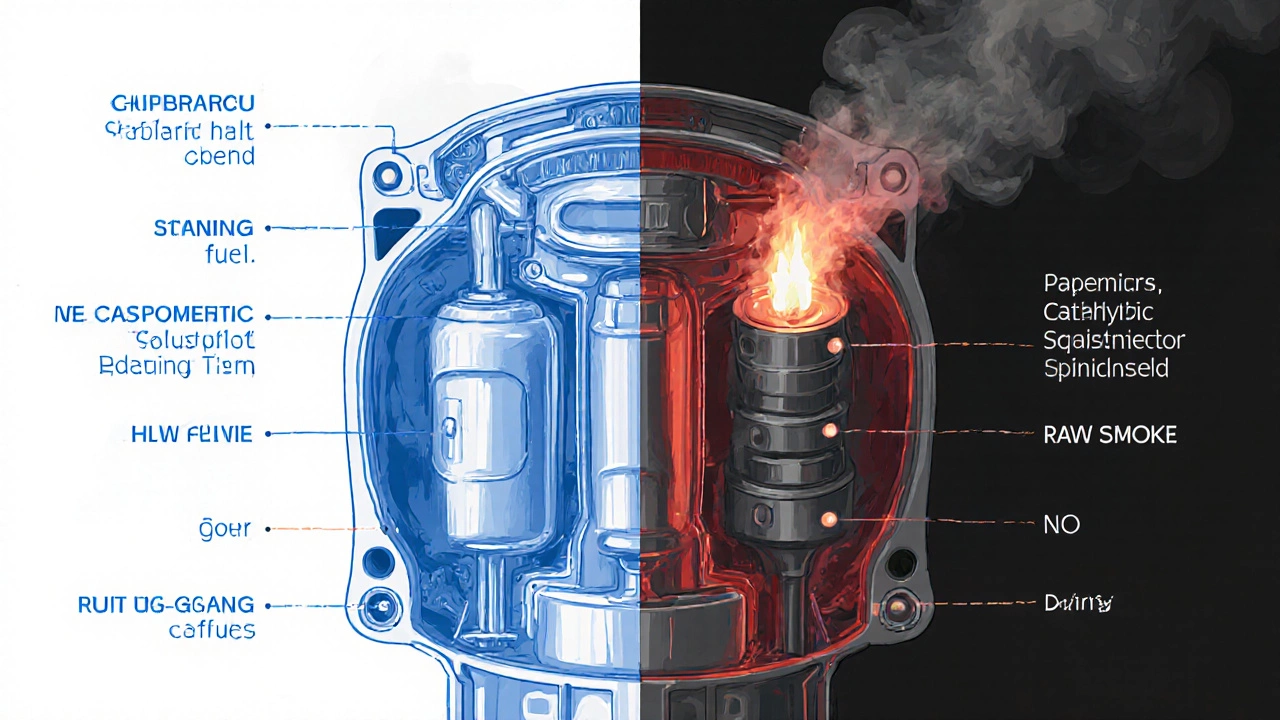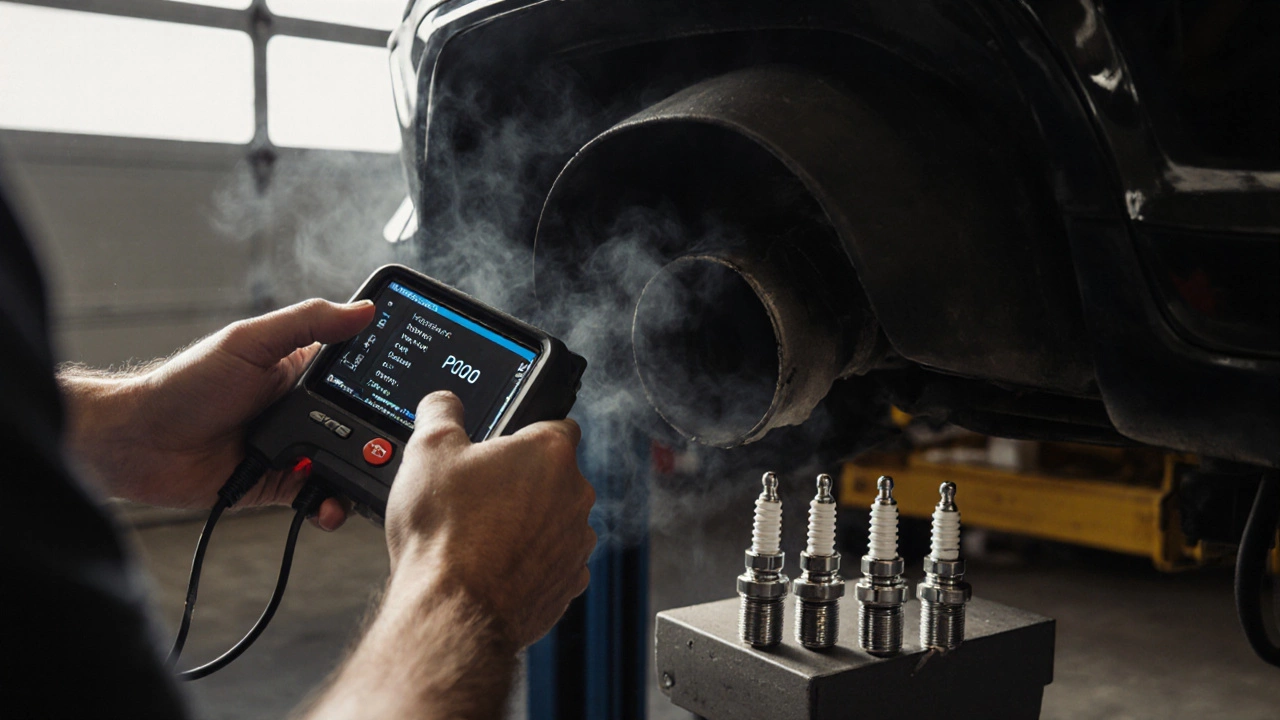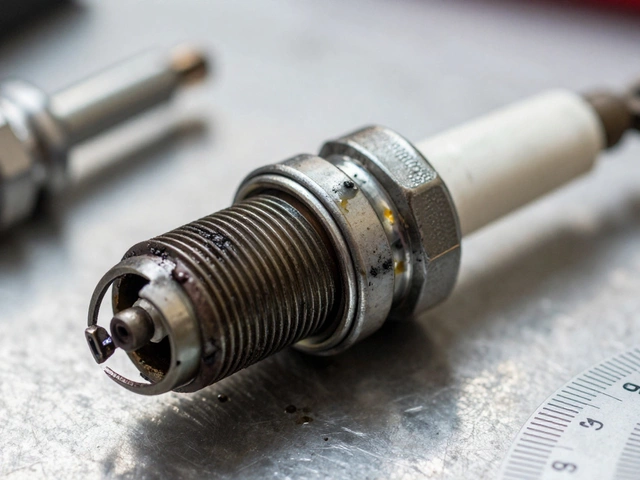Spark Plug Impact Calculator
Input Your Vehicle Details
How This Works
Based on automotive industry data, worn spark plugs can increase hydrocarbon emissions by up to 70% and reduce fuel efficiency by 10-20%. This calculator estimates your potential impact based on your vehicle's mileage and plug type.
Your Results
Estimated Emissions Increase
This could cause your vehicle to fail emissions tests in regions with strict regulations.
Financial Impact
Replacing spark plugs costs £30-£80 and can save you up to £300 in fuel costs annually.
Ever noticed your car’s exhaust sounding rougher than usual, or seeing black smoke puffing out the tailpipe? You might blame the exhaust system-but the real culprit could be hiding in plain sight: your spark plugs. It’s not obvious at first, but worn or faulty spark plugs don’t just make your engine run poorly-they directly mess with what comes out the back end of your car. And if you’re trying to pass an emissions test or just want to save fuel, ignoring this link could cost you more than you think.
How Spark Plugs Work (Simply)
Spark plugs are the tiny ignition switches inside your engine’s cylinders. Every time the piston compresses the air-fuel mixture, the spark plug fires a high-voltage spark-like a mini lightning bolt-that ignites it. That explosion pushes the piston down, turning the crankshaft, and ultimately moves your car. Simple, right? But it only works if the spark happens at the exact right moment, with the right strength.
Modern engines rely on precise timing and complete combustion. If the spark is weak, late, or missing entirely, the fuel doesn’t burn fully. That leftover fuel doesn’t vanish-it gets pushed out through the exhaust valve and into the exhaust system. That’s where the trouble starts.
What Happens When Spark Plugs Fail
Bad spark plugs don’t just make your engine misfire-they change the chemistry of what exits your tailpipe. Here’s how:
- Unburned fuel enters the exhaust: When a plug fails to ignite the mixture, raw gasoline flows into the exhaust manifold. This isn’t just waste-it’s flammable. It can ignite in the hot exhaust, causing popping sounds or even damaging the catalytic converter.
- Increased hydrocarbons (HC): Unburned fuel means higher HC emissions. Emissions tests measure this. If your spark plugs are worn, your car will likely fail.
- Carbon buildup: Incomplete combustion leaves behind soot and carbon deposits. These stick to the inside of exhaust valves, the catalytic converter, and even the oxygen sensors. Over time, this clogs everything up.
- Overheated catalytic converter: The catalytic converter is designed to burn off leftover fuel. But if too much raw fuel floods in from bad spark plugs, it overheats. Many people replace catalytic converters thinking they’re broken-when the real problem was neglected spark plugs.
- Black smoke from the exhaust: Thick, dark smoke isn’t normal. It’s a clear sign of rich fuel mixture and incomplete burning-often caused by weak or fouled spark plugs.
One real-world example: a 2018 Honda Civic in Manchester came in for a failed MOT. The owner thought it was the exhaust pipe rusting. Turns out, three of the four spark plugs were covered in oily carbon deposits. Replacing them cut HC emissions by 68% and eliminated the smoke.
How Exhaust Symptoms Point Back to Spark Plugs
You don’t need a diagnostic tool to spot the connection. Watch for these signs:
- Engine misfires or jerks during acceleration
- Reduced fuel economy-your tank empties faster than usual
- Hard starting, especially in cold weather
- Exhaust smells like gasoline, not just hot metal
- Check engine light on, with codes like P0300 (random misfire) or P0420 (catalyst efficiency low)
These aren’t random glitches. They’re symptoms of the same root problem: fuel isn’t burning where it should. And when it doesn’t, it ends up in the exhaust.

Spark Plug Types and Their Impact
Not all spark plugs are the same. Using the wrong type can make exhaust problems worse-even if the plug looks fine.
For example:
- Standard copper plugs: Cheap, but wear out fast (every 20,000-30,000 miles). They’re more likely to misfire under load, leading to excess emissions.
- Platinum or iridium plugs: Last longer (up to 100,000 miles), fire more consistently, and burn fuel more completely. They reduce exhaust pollution over time.
- Wrong heat range: If your plug runs too cold, it won’t burn off carbon deposits. Too hot, and it can cause pre-ignition, damaging valves and increasing NOx emissions.
Always use the spark plug type your manufacturer recommends. A 2022 Toyota Corolla doesn’t need the same plug as a 2019 Ford Focus. Using the wrong one can turn a clean exhaust into a pollution source.
When to Replace Spark Plugs to Protect Your Exhaust
Most manufacturers say to replace spark plugs every 30,000 to 100,000 miles. But that’s just a guideline. Real-world conditions matter more.
Replace them sooner if:
- You drive mostly short trips (under 10 miles) - the engine never warms up enough to burn off deposits.
- You use low-quality fuel - additives can foul plugs faster.
- You notice any of the exhaust symptoms listed above.
- You live in a place with strict emissions testing, like the UK’s MOT.
On average, UK drivers replace spark plugs every 45,000 miles-far sooner than the max interval. That’s not overkill. It’s smart maintenance.

What Happens If You Ignore It
Letting bad spark plugs go too long doesn’t just hurt your emissions-it can break expensive parts.
The catalytic converter is the most vulnerable. It’s designed to handle small amounts of unburned fuel. But if you’ve been driving with misfiring plugs for months, the converter gets overloaded. It can melt internally, turning into a ceramic brick. Replacing one costs between £500 and £1,200 in the UK.
And if you fail an MOT because of high emissions, you can’t legally drive the car until it’s fixed. That means towing, repairs, and lost time.
Compare that to a set of spark plugs: £30-£80, depending on type. And you can install them yourself in under an hour.
Quick Check: Is Your Spark Plug Affecting Your Exhaust?
Here’s a simple 3-step check you can do yourself:
- Look at your exhaust pipe. Is there black soot around the end? That’s unburned fuel.
- Listen for popping or backfiring sounds when you let off the gas. That’s fuel igniting in the exhaust.
- Check your last service record. If spark plugs haven’t been changed in over 40,000 miles, they’re overdue.
If two or more of these are true, your spark plugs are likely causing exhaust problems.
Bottom Line: Spark Plugs and Exhaust Are Connected
Spark plugs don’t just start your engine-they control how clean your exhaust is. Bad plugs mean dirty exhaust. Dirty exhaust means failed emissions tests, damaged converters, and wasted fuel.
Replacing spark plugs on time isn’t just about engine performance. It’s about keeping your exhaust system healthy, your car legal, and your wallet full. Don’t wait for smoke or a warning light. Check your plugs before they start costing you more than they’re worth.
Can bad spark plugs cause a check engine light?
Yes. Faulty spark plugs often trigger misfire codes like P0300, P0301, or P0304. These indicate one or more cylinders aren’t firing properly. The engine control unit detects the imbalance and turns on the check engine light. Ignoring it can lead to secondary damage, like a failed catalytic converter.
Will new spark plugs improve exhaust emissions?
Absolutely. Fresh, properly gapped spark plugs ensure complete fuel combustion. This reduces hydrocarbon (HC) and carbon monoxide (CO) emissions significantly. Many cars that fail emissions tests pass after a spark plug replacement-no other changes needed.
Can spark plugs cause black smoke from the exhaust?
Yes. Black smoke means unburned fuel is exiting the exhaust. This happens when spark plugs misfire or are fouled, leaving fuel unignited in the cylinder. The fuel then passes through the exhaust system and burns in the hot pipe, creating visible soot.
How often should I replace spark plugs in the UK?
For most UK drivers, replace spark plugs every 40,000 to 60,000 miles. If you do a lot of short trips, stop-start driving, or use lower-grade fuel, replace them every 30,000 miles. Always follow your car’s manual-but err on the side of caution if you’re unsure.
Do iridium spark plugs reduce exhaust emissions more than copper ones?
Yes. Iridium plugs produce a stronger, more consistent spark than copper. This leads to more complete fuel burning, which directly lowers hydrocarbon and nitrogen oxide emissions. They also last longer, meaning fewer replacements and less long-term pollution.
If you’ve noticed your car running rough or your exhaust looking dirty, don’t assume it’s the muffler. Start by checking your spark plugs. They’re small, cheap, and often the real reason your exhaust isn’t working right.








